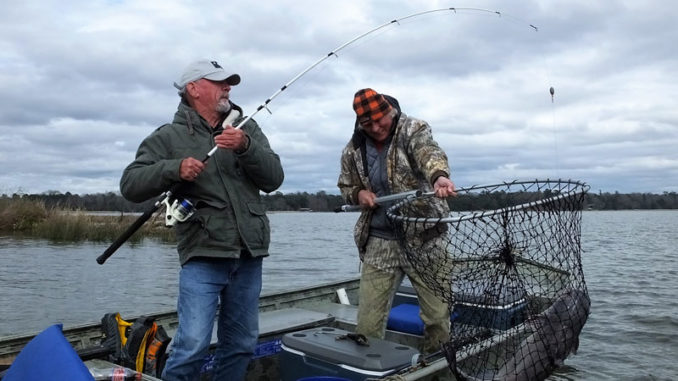
Cold weather months offer great catfish action on Cooper River
The Cooper River downstream from Lake Moultrie is an amazing fishery for multiple species. And being located near a big population center in South Carolina, this waterway gets a lot of well-deserved fishing attention.
Catfishing opportunities are excellent year-round, with spring being the high-profile time to hook monster catfish. But the cold-weather fishing in January and February may be one of the few overlooked fishing adventures on the river.
Lonnie East has years of fishing experience on the Cooper River. Hailing from nearby Goose Creek, East has unlocked the secrets to consistently catch huge catfish during the coldest months.
“Spending time on the river and learning the seasonal patterns of what catfish and other species are doing is essential,” he said. “The winter fishing pattern is different from the spring. We’re fishing for the same fish, just in different places. And as always, the key to where big catfish go is the food. And that in turn is dictated by the tides.”
East prefers to fish from his 14-foot johnboat; he said he’s earned the appropriate moniker, “River Rat.”
“I began fishing the Cooper River in the 1950s with my dad and have fished it hard ever since,” he said.
Knowing his stuff
East has fished without a depth finder, yet he’s unlocked the secret locations to specific underwater targets. On a trip with East last winter, in a friend’s boat equipped with modern sonar, East described every place we approached in detail before we arrived, in terms of depths, eddies and current flow, and he was dead on-target every time, even with changing water levels with the tide. We literally did not need electronics. But without a “river rat” in the boat, the rest of us need sonar.
“By studying the river for decades, I’ve learned where the best targets are located at various tides,” he said. “Understanding where eddies form and how they change with tidal flow helps me pinpoint targets. Fishing success here is not random, it’s a specific, target-oriented pattern.”
Winter Catfish
East said during the winter, catfish begin to stage on the shallower breaks and cuts along the main-river channel. Specific spots include creek and river junctions, river bends and cuts and breaks off the river leading into old rice fields. These areas where water flows merge create eddy currents as the water flows in or out of the cuts and creates prime feeding areas.
The fishing setups are always different, based on the tide.
“I don’t have to fish the really deep water at this time of the year to catch big catfish,” he said. “The catfish come to feed, and that’s a big advantage for the fisherman.”
East said on a rising tide, catfish flood back into shallow areas or into the rice fields to forage. That’s a large target to pinpoint, so he concentrates on the ingress and egress locations.
“I’ll move shallower up the ledges as the incoming tide floods into the old rice fields and flats and fish the edge and around the opening,” he said. “On the dropping tide, I’ll move to slightly deeper water and cast to the breaks where eddies exist along the ledge of the river. I’ll make small, corrective moves every 30 minutes to ensure I’m fishing the eddies properly because they’re constantly changing with the tidal flow.”
Tactics, Tackle for Cooper River catfish
East said catfish forage on multiple targets of opportunity, and the river offers a variety of food sources.
“Threadfin, gizzard shad and mullet are abundant, and at this time of the year, the shad and herring spawning runs begin,” he said. “I also know these big catfish go really shallow on the flats on rising water, because I’ve caught plenty of catfish with whole, recently-eaten, coots in their belly. Some were so freshly eaten I’ve considered using ‘cut coot’ for bait, but I prefer to use big chunks of shad, herring and mullet.”
East uses standard spinning or baitcasting tackle: 7- and 7 1/2-foot rods and reels spooled with heavy monofilament. He uses an 18- to 30-inch leader and a 1- to 2-ounce sinker depending on current flow and depth. He typically fishes three rods, two in holders and one he hand-holds to add a “personal” touch.
East said the challenge of successfully fishing the river is often simply adapting to the never-ending changes that occur with tides, water level and the diversity of forage.
“I’ll move regularly because I’m targeting actively feeding fish,” he said. “If I’m in the right area, fish will usually bite quickly, so I seldom linger longer than 30 minutes. Some moves may only be 30 yards, some may be miles. But it’s the hunt for these big catfish is what I love, and when I find them, my ole river produces awesome fishing.”


Be the first to comment